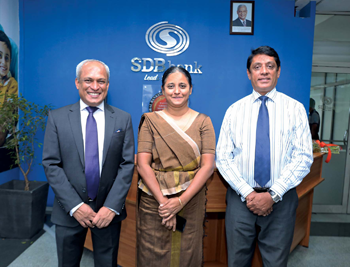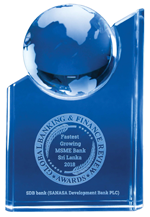SANASA DEVELOPMENT BANK
Q: How would you describe the banking sector in Sri Lanka?
A: My initial observation is that we operate in an overbanked market – there are over 20 commercial banks and specialised banks, and more than 50 finance companies, to service a population of a little over 21 million people.
This is understood better by comparing these figures with Australia, which has four or five banks for a population of around 24.6 million; or even Malaysia, which is home to a similar number of banks servicing a population in excess of 31 million.
Having said that, I believe this situation can also offer banks different opportunities in terms of competitiveness to maintain customer relevancy. However, it may be difficult to sustain such a market without consolidation.
Q: So what are the potential challenges and opportunities in pursuing consolidation?
A: Even though consolidation of the banking sector is a viable option, there is a risk even for SANASA Development Bank (SDB) of losing its identity and perceived uniqueness.
Many Sri Lankan banks prefer to operate under a commercial licence as this enables an easier reach. SDB is the brainchild of the cooperative movement, and we cater to different segments particularly focussing on micro, small and medium enterprises (MSMEs).
When considering consolidation, while it has its many benefits, banks must ensure that the merger or acquisition is with the right partners. Organisational culture and customer segments must be pre-evaluated to ensure a harmonious partnership.
Presently, I do not perceive a suitable partnership for SDB.
Q: How would you describe the competition and what strategies does your bank employ to stay ahead?
A: All banks fundamentally provide two services – deposits and loans. Customers continuously seek the best rates for their savings and fixed deposits; but they want the lowest rates when it comes to lending.
I believe that people engage in transactions with a bank for many other reasons – such as an experience, the bank’s network or even the relationship between the individual and the bank. Sometimes it could be through referral, which is more common in Sri Lanka.
Developing our human resources is vital to create a positive experience when a customer banks at one of our branches. Therefore, we strengthen our presence by pursuing differentiation.
Technology is also used for differentiation in a saturated market. However, a digital presence or mobile application alone will not suffice. I believe that we need to incorporate technology with our value added services (VAS) – thereby making it customisable, timely and relevant to our segments – and also aim to provide a frictionless and seamless service to attract more lifelong customers.
Q: Being in both the banking and technology sectors for more than 30 years, how do you view the bank’s digital impact on the MSME community?
A: By analysing the activities that cooperatives are engaged in and identifying their pain points, technology will certainly play a major role in creating solutions for our customers.
Many MSME owners rarely visit a bank except to open an account for their newborns. Take for example, the fisher folk community. We can encourage digital transactions for their daily dealings with other merchants and foster an attitude of saving.
The interest earned annually would encourage them further in regard to the benefits on offer. Security for their finances and generating a favourable credit score would also be advantageous if the need for lending arises.
SDB aims to empower customers with the right technology and the information they need to make better decisions regarding their finances. This in turn would derive greater economic benefit for the country as well. Technology has the ability to make SDB more relevant to the MSME community’s needs by adding value to their lives, and creating wealth for each and every customer according to their stage in life.
Sri Lanka has good banking sector infrastructure such as the interbank payment network, which makes same day transactions of up to Rs. 5 million convenient. These benefits are integrated with the cooperative model under which SDB operates. As a bank, we aim to be indispensable in the daily transaction flow of our customers – be it in transport, shopping or groceries – as this is part of our holistic approach to customer engagement.
Q: As you begin this new season, what can we expect from SDB in the near future?
A: At SDB, we are presently enhancing the customer experience by means of recon- figuring our channels and developing our people. This is crucial to being relevant and providing services that even the least informed customer could use confidently.
We will facilitate a seamless experience across our digital channels and bank branches, by maintaining a certain standard and exploring new opportunities created through the digital arena; and these factors in turn will provide our business with a cutting edge and propel SDB to revolutionise the banking sector.
Thilak Piyadigama
Chief Executive Officer
Telephone 2832500
Email info@sdb.lk
Website www.sdb.lk






